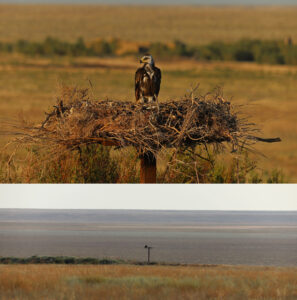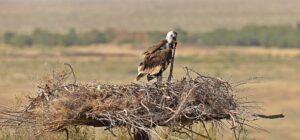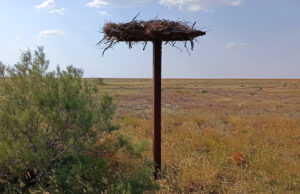Third International Scientific and Practical Conference “Eagles of the Palearctic: Study and Conservation”
Raptors Conservation. Suppl. 2. Proceedings of Conferences
Experience of using artificial nesting platforms for the Steppe Eagle in the south of Kostanay region, Kazakhstan (in Russian)
Timoshenko A.Yu., Putilin A.V., Salemgareev R.R., Timoshenko G.Yu., Batyrkhanuly K. (Association for the Conservation of Biodiversity of Kazakhstan, Astana, Kazakhstan)
Contact:
Alexey Timoshenko alexey_timoshenko@acbk.kz
Alexander Putilin aleksandr.putilin@acbk.kz
Radik Salemgareev rad_1984@mail.ru
Georgy Timoshenko zhora.timoshenko88@gmail.com
Kanat Batyrkhanuly bat_kana@mail.ru
Recommended citation: Timoshenko A.Yu., Putilin A.V., Salemgareev R.R., Timoshenko G.Yu., Batyrkhanuly K. Experience of Using Artificial Nesting Platforms for the Steppe Eagle in the South of Kostanay Region, Kazakhstan. – Raptors Conservation. 2023. S2: 266–268. DOI: 10.19074/1814-8654-2023-2-266-268 URL: http://rrrcn.ru/en/archives/35061
Steppe Eagle (Aquila nipalensis) population currently continues to decline in Kazakhstan, the south of the Kostanay region is no exception. The reasons for the decline are of different nature, both abiotic and biotic, and include the following: destruction of nests by land predators (most often Steppe Eagle nests are located on the ground); steppe fires are of great threat, and the fact that some nests are located on trees and bushes does not help, but rather aggravates the situation; destruction of nests by livestock; developing new areas for farms, etc., as a result, Steppe Eagles are forced to leave favorable nesting territories; electrocution on power poles as Steppe Eagles use traverses to build nests.
Artificial structures, such as nesting platforms, are widely used to attract raptors. During the implementation of the project “Steppe Eagle Conservation in Kazakhstan” within the international campaign “Flyway Champions”, 35 platforms were installed in favorable Steppe Eagle nesting biotopes in “Saga” and “Altybay” hunting grounds (managed by ACBK – Association for the Conservation of Biodiversity of Kazakhstan) in the South of the Kostanay region in the summer of 2021. The design is made entirely of metal, consists of a support with a cross section of 100×100 mm and a height of 3 m, where 1 m is buried in the ground, and a “basket” with dimensions of 1×1 m installed at the top. Various shrub and tree branches are placed and attached to the “basket”, designed to imitate an active nest. This design is protected from terrestrial predators, and most importantly, from steppe fires. In the breeding season of 2022, Steppe Eagles occupied three platforms, in 2023 – two. It is noteworthy that a pair of eagles used the same nest in both seasons. As an experiment, in 2021 an old nest of Long-Legged Buzzard (Buteo rufinus) was moved to one of the platforms, and in 2023 it was occupied. In 2022, one of three pairs left the nest for unknown reasons after completing it; in the remaining two, a clutch of two eggs was observed; later we observed down feathers, but only one nestling remained in the nest by the time of the departure. In 2023, clutches on two platforms consisted of two eggs each, but later two and one nestling were observed there, having left the nest in the same number. Nesting platforms also serve as a “perch” for a number of birds, and after the use by Steppe Eagles, Indian Sparrow (Passer indicus) occupies them; the number of such a colony reached 13–16 nests. It is also worth noting that sometimes the distance between occupied nesting platform and occupied natural nest is less than 2 km, which suggests that there is a need for this biotechnical activity.

Steppe Eagle (Aquila nipalensis) nestling in the nest on an artificial nesting platform. Photo by A. Timoshenko.

Steppe Eagle (Aquila nipalensis) nestling in the nest on an artificial nesting platform. Photo by A. Timoshenko.

